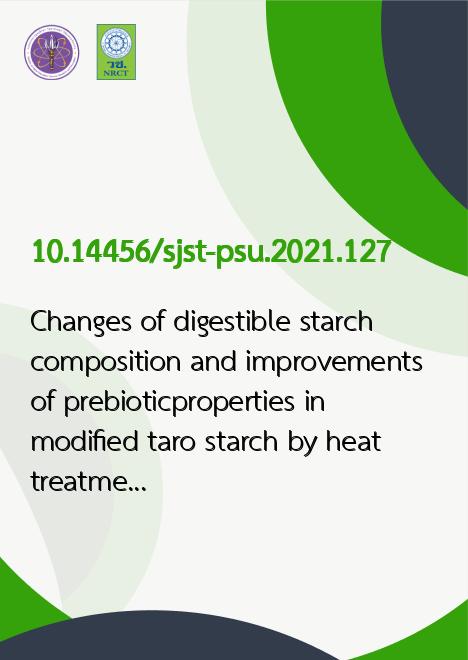
|
Changes of digestible starch composition and improvements of prebioticproperties in modified taro starch by heat treatment |
|---|---|
| รหัสดีโอไอ | |
| Creator | 1. R. Haryo Bimo Setiarto 2. Harsi Dewantari Kusumaningrum 3. Betty Sri Laksmi Jenie 4. Tatik Khusniati 5. Nunuk Widhyastuti 6. Sulistiani |
| Title | Changes of digestible starch composition and improvements of prebioticproperties in modified taro starch by heat treatment |
| Publisher | Research and Development Office, Prince of Songkla University |
| Publication Year | 2564 |
| Journal Title | Songklanakarin Journal of Science and Technology (SJST) |
| Journal Vol. | 43 |
| Journal No. | 4 |
| Page no. | 969-975 |
| Keyword | digestible starch, heat treatment, modified taro starch, prebiotic activity, prebiotic index |
| URL Website | https://rdo.psu.ac.th/sjstweb/index.php |
| ISSN | 0125-3395 |
| Abstract | This study investigated the composition of digestible starch and prebiotic properties of taro starch due to differentheating treatments. The taro starch has been treated by annealing (24 hrs, 50 ?C), heat moisture treatment (moisture 25%, 3 hrs,110 ?C), and autoclaving (15 min, 121 ?C) with cooling (24 hrs, 4 ?C) for 1, 2, and 3 cycles. Results showed that resistant starch(RS) and slowly digestible starch (SDS) contents in the modified taro starches (MTS) by all heat treatments increasedsignificantly. Furthermore, MTS by autoclaving-cooling two cycles (AC-2C) showed the best prebiotic properties indicated byhigh resistance in simulated gastric acid (90.19%), high prebiotic effect (2.45), high prebiotic index (1.96) as well as prebioticactivity (0.072) towards Enteropathogenic Escherichia coli (EPEC). This MTS also has high RS (21.34%) and SDS (27.17%)content as well as low digestibility (64.41%). Hence, AC-2C MTS is very prospective to be used as the prebiotic source. |
